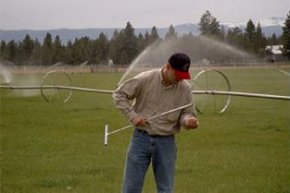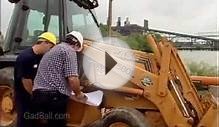
Agricultural engineering is a combination of engineering technology and biological science applied to the field of agriculture. These engineers apply their knowledge and skills to improve sustainable agriculture production. Agricultural engineers are involved in many diverse projects, including the design of machinery and structures, such as housing for large hog operations, and the development of methods to conserve soil and water and improve the processing of agricultural products.

At a glance
Imagine you are standing in a hilly field of potatoes watching as a crane slowly lowers a 10-metre section of aluminum pipe into a freshly dug trench. Behind the crane, a crew is busy welding the pipe sections together. You are watching all this activity because this is your design. You're an agricultural engineer who specializes in designing irrigation systems, which is why the local irrigation district has hired you. Several summers of drought conditions have decreased the productivity of dry-land fields, and the irrigation district needed to find a way to extend its system and carry water to the parched areas. You have been brought in to design a system of piping and reservoirs that will give farmers the water they need to grow their crops.
As an agricultural engineer, you combine your knowledge of pipeline design and construction with information on the area's geography, climate, and crop rotations in order to design a new system for piping irrigation water from the district's canals to dry-land fields. You gather information on the local water table and historical weather data, particularly the longest periods between rainfall, as well as the water demands of different crops, so you know how large to make the reservoirs and connecting pipes. Then you look at localized elevation and slope changes to determine the optimal placement for the reservoirs. These reservoirs need to be down grade from the canal, so the forces of gravity will keep the water moving. Finally, you use your irrigation schedule and water-flow rates to determine the type and size of pipe needed. When completed, water will flow from the canals through a system of pipes you have designed and into reservoirs from which farmers can pump the water onto their fields.
Job duties
Duties vary significantly from job to job, but the following list includes typical job duties one might encounter as an agricultural engineer:
- Plan, design, and supervise the building of irrigation, drainage, and flood- and water-control systems.
- Plan, design, and supervise the construction of agricultural buildings and storage facilities, such as livestock structures, greenhouses, silos, and cold-storage facilities for apples.
- Design and evaluate equipment used for ground preparation, seeding, spraying, harvesting, and transporting agricultural goods.
- Ensure design is consistent with local codes and all required permits obtained.
- Supervise the cleaning, milling, grading, mixing, processing, cooling, packaging, and distribution of agricultural products.
- Prepare and present technical reports, meet with clients, and communicate technical concepts to colleagues and clients with non-technical backgrounds.
- Conduct research to find new sustainable ways to produce food and fibre for consumers.
- Conduct research for the design of innovative new structures and systems.
- Conduct research to develop new technologies and management practices for food production that protect environmental resources.
Work environment
Agricultural engineers work in a variety of locations, including:
In the office:
- Doing paperwork, analyzing data, and preparing reports
- Drafting construction plans and designing computerized management plans
- Planning projects, administering and managing budgets
- Communicating on the phone and in meetings with clients, stakeholders, and government departments and presenting to clients designs, ideas, and recommendations
- Researching and collecting background information and consulting with other engineers and professionals
RELATED VIDEO












